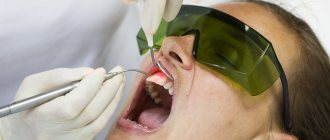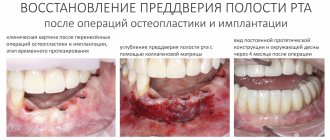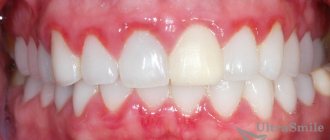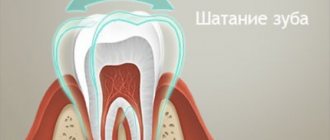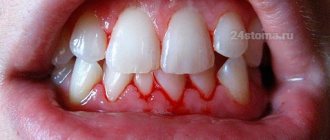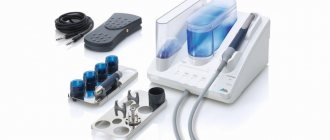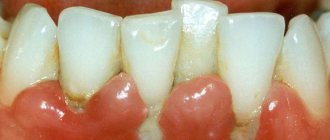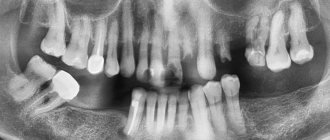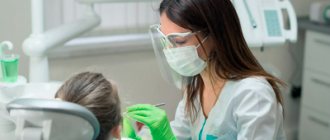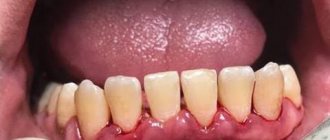HomePeriodontologyTreatment of periodontal disease with SIEMENS laser
The main reason patients visit a dental clinic is severe pain. Different diseases of the teeth and gums may have similar symptoms, and only a specialist can make an accurate diagnosis. The most common is periodontal disease. If treatment is not started in a timely manner, the development of the disease leads to inevitable tooth loss. Therefore, it is necessary to contact a dentist when the first symptoms of the disease occur.
Causes of periodontal disease development
The appearance of periodontal disease occurs for various reasons. As a result of examining more than 750 thousand patients, US scientists found that the disease primarily develops due to bacterial plaque on the teeth and a decrease in the body’s immune defense. It has been established that microorganisms that live in deposits and plaque on teeth are directly related to the development of the disease. It is the waste products of these microbes that have a negative effect on the gums and dental tissue, causing their destruction.
First, a person notices bleeding gums while brushing their teeth, which can also be accompanied by pain. Therefore, the process of oral and dental hygiene becomes more careful and of lower quality. As a result, plaque only increases, turning into tartar. At the same time, the environment for the development of microorganisms becomes especially beneficial.
During this time, inflammation and periodontal condition only worsens. Moreover, the negative process affects the activity of microvessels, which reduces nutrition, accelerating destruction. After this, the inflammatory phenomenon affects the bone tissue.
Another reason for the development of periodontal disease lies in the disruption of immune defense. The human body can be subject to disruptions due to stressful situations, trauma, and hormonal problems. As a result, immune cells perceive periodontal tissues as foreign and attack them. Such exposure causes aseptic inflammation of the gum tissue with subsequent death. Then the negative process moves to the bone tissue. The third stage of the disease is characterized by loosening and loss of teeth.
The following factors can aggravate the course of the disease: diabetes, smoking, gastrointestinal disorders, stress, hormonal imbalances, advanced caries, poor dentures and malocclusion.
Laser at the Mine Clinic – treatment without pain and discomfort!
Laser treatment helps eliminate gum disease even in the most advanced cases. In dentistry, laser treatment is performed in a hygienically clean office using the latest equipment. Modern equipment allows laser therapy to be performed at the highest level without damaging the gums. We have the best laser treatment in Moscow that a patient can hope for.
The Mine Clinic uses equipment in treatment that:
· has a powerful hemostatic effect;
· can program the procedure;
· stimulates metabolic processes in the gums;
· disinfects and disinfects fabrics;
· does not cause swelling or discomfort during the session;
· prevents bleeding gums.
Laser treatment of gums with us does not have any negative effects on the body and is carried out under the supervision of the best dentists - laser treatment of gums (Moscow) takes place without blood and without pain. The cost of the procedure can be clarified in advance with the doctor or clinic administrator.
Periodontal disease - symptoms and signs
The first signs of the development of the disease include:
- Itching and discomfort in the gums;
- Bleeding while brushing teeth;
- Swelling and change in the shape of the gums;
- Unpleasant odor;
- Specific salty taste in the mouth.
If therapy is not started in a timely manner, purulent lesions will soon form in the gums. Pain increases, its color, shape and structure change.
In such cases, enlarged lymph nodes cannot be ruled out. And x-rays will show pathological changes in bone tissue with inflammatory foci and destruction of interdental septa.
Indications for gum surgery
There are two types of reasons that can influence the decision to have gum surgery:
- congenital
One of the most common defects is “long” gums. They visually shorten the tooth and cause discomfort during eating and care procedures. The cause of the deficiency is usually jaws of different sizes and a short upper lip.
An uneven edge of the gums of the upper, lower jaw or both is also a reason for surgical intervention.
- acquired
Mechanical injuries, unsuccessful treatment or tooth extraction, complications after inflammatory processes are sufficient grounds for the help of a cosmetic surgeon.
Some of the most common indications for cosmetic surgery are:
- periodontitis - inflammation of the gum and bone tissues of the tooth (periodontal tissues);
- gingivitis is an inflammatory process manifested in severe redness and bleeding of the gums.
Plastic surgery allows you to shorten or lengthen gum tissue
Periodontal disease - how is it diagnosed?
Correct treatment of periodontal disease is possible only after a thorough diagnosis. However, one examination by a dentist will not be enough. You should undergo tests using modern equipment and drugs.
In the dental practice of the Bionic Dentis clinic, the German protocol is used to examine patients. This allows you to conduct a full examination and accurately make a diagnosis.
This examination includes:
- Inspection using an optical system that allows you to significantly enlarge the inspected surface and not miss even the slightest damage;
- Testing for hidden plaque on teeth. To do this, a special preparation is applied, which indicates the places where harmful microbes accumulate;
- Determination of inflammation using a marker drug that can indicate lesions;
- Bana testing, which helps identify microorganisms that cause the development of the disease. Thanks to this technique, a competent selection of antibacterial therapy occurs. Specialists from the Bionic Dentis clinic were among the first to conduct bana testing in Russia;
- An X-ray and orthopantomographic examination procedure that allows you to assess the condition of all dental tissues that are not visible during a simple examination. This helps prevent and prevent further development of inflammation.
After reviewing the results of a complete diagnosis of the patient, specialists at the Bionic Dentis clinic draw up a treatment plan. This approach allows us to completely cure 99% of patients suffering from periodontal disease who contact us.
Gingivoplasty of gums
The changed shape of the gums (due to features in the structure of the jaw, intrauterine problems with the formation of periodontal disease) is not an obstacle to an even smile. Regardless of the cause of the defect, cosmetic surgery of soft tissues - gingivoplasty -
.
Prepare for surgery in advance by doing:
- general blood analysis;
- analysis for Rh factor, HIV, sugar level, prothrombin;
- blood clotting test (coagulogram);
- ECG.
No later than a week before plastic surgery, the patient should avoid drinking alcohol. On the day of the operation, you need to follow a diet: several hours should pass between meals and the procedure.
The attending physician should be aware of allergies, contraindications, chronic diseases and individual intolerance to specific drugs or their components.
Before plastic surgery, professional teeth cleaning is performed. If necessary, periodontal pockets are examined.
Gum grafting solves the problem of an “ugly” smile
When is gingivoplasty performed?
Gum plastic surgery is performed for deviations and serious pathologies, including:
- exposure (recession) of the tooth root. This reason is the most common;
- advanced gingivitis and periodontitis, in which the neck of the tooth is exposed;
- an anomaly called “gummy smile”, when a person smiles not with his teeth, but with his gums;
- correction of bite;
- correction of gums after tooth extraction;
- implantation and bone grafting.
In addition, your doctor may recommend gingivoplasty if necessary:
- align the edges of the gums;
- make the gum longer or shorter;
- improve the general condition of the gums.
Features of gingivoplasty
Gingivoplasty is performed to augment or remove soft tissue. In the first case, the procedure is carried out using a locus or membrane (matrix) method.
Patchwork method
consists of transplanting part of the patient's own tissue into the affected area. No additional materials are required for the operation. This method is more labor-intensive than the matrix analogue, but, nevertheless, is most in demand.
In the second case, the surgeon works with collagen matrices
or
barrier membranes
. Auxiliary material is sewn to the problem area, correction is carried out by building up tissue over the matrix/membrane.
The use of a laser speeds up the procedure and simplifies tissue healing
Not only a shortage, but also
an excess of tissue
is considered a disadvantage.
Even the term “gum smile” or “shark smile” has appeared, in which the gums protrude strongly and partially cover the teeth. The problem is solved by removing tissue and correcting the entire gingival contour. Depending on the affected area, gum surgery can be:
- local, when a small area is treated;
- global, affecting a group of teeth or the entire oral cavity.
The procedure is performed under local anesthesia and takes on average from 30 minutes to one hour. The use of laser equipment accelerated the process, allowing:
- reduce the likelihood of injuries and complications;
- facilitating healing and recovery during the rehabilitation period.
Rehabilitation period
The postoperative period depends on the individual characteristics of the body and the complexity of the procedure, and lasts, as a rule, from a week to three. The swelling subsides earlier - around the third day.
If you follow all recommendations for oral care, recovery will go faster. What's prohibited
:
- eating immediately after surgery. Eating is allowed no earlier than after 5-10 hours;
- spicy, sour, salty dishes, as well as solid foods, dishes with a strong strong taste are prohibited for the entire rehabilitation period;
- smoking for 5-10 hours after the procedure;
- After 2-3 hours, you can drink boiled or still unsalted water at room temperature (warm is fine).
In addition, it is necessary
:
- rinse your mouth with disinfectant solutions as recommended by your doctor;
- wear a mouth guard in the area affected by the dental surgeon. Fixing soft tissues will protect them from deformation. The period of use of protection is determined individually and, as a rule, is 7-10 days;
- avoid any traumatic effects not only on the plastic surgery site, but also on the entire oral mucosa;
- refrain from physical activity, going to the gym and swimming pool. Flights and hikes should be postponed until complete recovery;
- Monitor your body temperature: do not overheat and do not get too cold.
Brush your teeth
After the operation,
you can and should
at least twice, but this should be done
as carefully as possible
, without touching the correction area.
If you experience fever, prolonged swelling, bleeding, or severe pain in your gums, you should immediately consult a doctor.
The list of reasons that make plastic surgery impossible includes intolerance to anesthesia and cancer.
Stages of a unique technique:
- 1. Begin therapy with ultrasonic cleansing of the entire tooth and its root. This removes plaque and stones. The use of ultrasound allows you to thoroughly clean even the most difficult to reach areas without pain or injury to the enamel. Specialists at the Bionic Dentis clinic perform this procedure using a special Sirosonic Sirona Siemens ultrasound device, manufactured in Germany. In this case, the level of processing is selected individually, which significantly increases work efficiency.
- 2. The second stage includes the removal of pigmented plaque and microscopic deposits located in hard-to-reach places. For this, the Air Flow technique is used. The method is implemented using a Prophyflex dental handpiece from the German company Kavo, from which mixed air and abrasive are released under high pressure. This mixture allows you to effectively eliminate the remains of infection and other contaminants. The peculiarity of the method is the use of calcium carbonate, which has a gentle effect on the gums and root system of the tooth. In combination of this drug with the Prophyflex device from Kavo, the procedure is performed with the utmost quality.
- 3. At the third stage, laser sterilization of the root pockets and gum edges is performed. Doctors at Bionic Dentis use the Sirolaser Sirona Siemens dental laser (Germany). The laser tip is inserted into the gum pockets, which leads to the complete destruction of pathogenic bacteria that cause the disease. The unique laser setting allows not to damage the gums, but to have a detrimental effect on microbes.
- 4. The fourth stage includes drug therapy using calcium copper hydroxide. The medicine is placed in the gum pockets, leaving it there for a long time. The drug relieves inflammation and sterilizes periodontal pockets in which the pathological process has begun. Our specialists use a patented original drug from the German company Humanchemie. This manufacturer is also the developer of this medicine.
- 5. At the fifth stage, the metabolism in the gingival tissues is corrected. For this purpose, the active tissue regeneration complex prf is used. The patient first donates blood from a vein, which is subjected to special treatment. This makes it possible to isolate specific prf proteins. It is these substances that can trigger tissue restoration and healing processes in the human body. Due to the fact that the proteins are obtained from the blood of a specific patient, there are no side effects or allergic manifestations. The process of obtaining active proteins for regeneration is an important and responsible procedure, which is performed under strictly sterile conditions. For this purpose, Bionic Dentis specialists use a method invented by scientists from the Munich and Charité clinics (Germany).
Treatment of bleeding gums with laser
Treatment for bleeding gums
- a complex process that is difficult to control
standard methods.
Reviews from dentists indicate that in order to achieve the desired result, it is important to use modern technologies such as a laser and a Vector device. The situation with gum inflammation is complicated by the fact that patients often ignore the onset of the disease and turn to specialists at a later stage, when signs of bleeding gums and increased tooth sensitivity become permanent. With such symptoms, the help of a dentist is necessary, as there is a risk of aggravating the situation, which will ultimately lead to tooth loss. A periodontist
is a dentist who deals with the pathology of the tissues surrounding the tooth.
Causes of bleeding gums.
Most often, bleeding gums are caused by diseases such as:
- Gingivitis
– an inflammatory process limited to the gum tissue that occurs
without disturbing the periodontal connection. - Periodontitis
is a chronic disease characterized by damage to the supporting apparatus of the tooth and is a complication of gingivitis. The constant destruction of the bone tissue surrounding the tooth is accompanied by the formation of deep bone pockets, which, depending on the stage, are filled with dental deposits, granulations or purulent discharge. It often occurs in a latent form and progresses quickly.
The causes of pathological processes in gum tissue are:
- Poor oral hygiene.
- Anomalies of bite, accompanied by overload of the supporting apparatus of the tooth.
- Mistakes made during orthopedic treatment, when installing crowns and veneers.
- Incorrectly performed filling of teeth, with violation of occlusion.
IMPORTANT:
Periodontitis and periodontal disease are the initial manifestations that we see in the oral cavity, signaling more serious disorders in the body as a whole!
Symptoms.
The patient needs to pay attention to the following symptoms:
- Bleeding gums, which is detected by marks on the toothbrush.
- Pain when eating or after eating.
- Taste of blood in the mouth.
At the initial stage, the process takes on a wave-like character, these symptoms occur periodically and then subside.
In the absence of treatment, the symptoms of bleeding become permanent, since as the disease progresses, toxins (poisons) produced by bacteria living in the gingival stone destroy the periodontal tissues, which leads to the formation of gingival pockets that are filled with plaque. This adds bad breath and changes the appearance of the gums. They become swollen, reddened, signs of receding gums appear, and the spaces between the teeth increase. The disease takes a chronic form. In case of exacerbation, tooth mobility appears, the bone tissue surrounding the tooth is constantly destroyed, and deep bone pockets appear. IMPORTANT:
If left untreated, the situation can lead to tooth loss.
Treatment of inflammation and bleeding gums.
Treatment of inflammation and bleeding gums
depends on the reasons that caused the development of these pathological signs, the stage and clinical manifestations of the disease.
At the same time, treatment with medications in dentistry and the use of antibiotics have lost their relevance in modern dental clinics. The most modern treatment methods today are the Diode laser and the Vector system
. However, these two methods differ in their effectiveness and method of implementation.
In the classic version of gum treatment, before the Vector procedure
it is necessary to perform closed or, in severe situations, open curettage of bone pockets
to remove granulation tissue.
Curettage and cleansing of pockets is carried out under anesthesia, but causes patients a lot of negative aspects and pain after the procedure. Patients are often prescribed antibiotics, and
antiseptic drugs
Vector treatment of gums
It is carried out a month after curettage and allows you to get a more obvious result. By providing polishing of the root surface of the tooth, the device also guarantees a powerful preventive effect. Periodontists at the Dentist clinic have been successfully using this technology for 20 years. According to experts, the Vector device has significant advantages over a standard ultrasonic scaler, but is significantly inferior to laser technology for treating gums.
Laser gum treatment is the most innovative method. Diode laser ,
which is a powerful high-energy stream of light concentrated at one point. Acting purposefully, possessing hemostatic and bactericidal properties, the laser beam allows you to quickly destroy microbes and relieve pathological symptoms.
Since the action of the laser combines curettage and sterilization of the pocket, the technology is considered the most effective and painless in the treatment of periodontitis
.
Laser radiation gently evaporates granulations, does not injure the gums, unlike curettage, and sterilizes the pocket. A doctor who uses a laser in his work guarantees results as quickly
, in the shortest possible time. The effect is noticeable after the first procedure.
IMPORTANT:
Unlike Vector treatment, the diode laser has a great advantage in treatment, this is important. The technology is more expensive, but 100% effective.
Stages of diode laser treatment (laser curettage).
Laser curettage is the most modern and most effective technique for
today is the day to treat gums.
Instead of curettes and scalers, manipulations in the periodontal pocket are carried out using special fiberglass tips, different color coded and different sizes for each procedure. They are painted in different colors to make them easy to identify for different procedures.
The procedure for removing overgrown epithelial cells from the walls of the pocket by laser evaporation is called decontamination.
Laser curettage consists of several stages:
- Anesthesia is used or not, since the laser has an analgesic effect.
- Skyler removes tartar from teeth.
- Using fiberglass tips, radiation is delivered to the affected periodontal pocket, where tissue treatment is carried out. With horizontal and vertical movement in the pocket, the entire surface of the epithelium and connective tissue is processed. Evaporation of necrotic tissue kills bacterial flora.
- On average, laser exposure at one point of the pocket lasts 30 seconds, after which the gum pocket is treated with hydrogen peroxide.
- Therapy is discontinued when mild, continuous bleeding is observed.
The time of the procedure depends on the degree of periodontal pathology. As a result, necrotic tissue is evaporated and the pocket is sterilized. A photocoagulation film is formed on its walls, which will become an obstacle to the penetration of new microorganisms. Since radiation stimulates the adhesion process, the procedure creates conditions for the closure of the pocket. After completion of the session there is no need to apply a bandage. On average, the procedure can be performed every 10 days for the first month and then once a month for the next 5 months. After this, it is possible to regenerate tissue damaged by infection using laser therapy.
Advantages and disadvantages.
By using such advanced equipment, which has unique properties, to treat gums, it is possible to significantly increase the effectiveness of the treatment.
treatment, avoid antibiotics and surgery. The laser helps to effectively fight pathogenic microflora, and a tangible result of its impact is noted after the first procedure.
At the same time, sterilization of periodontal pockets, the process of decontamination, is carried out as carefully as possible, but very delicately. Using antiseptic solutions or mechanical cleaning for these purposes does not give such a significant effect. The laser effect is so pronounced that with timely treatment at an early stage, therapy can be limited to one session. Speaking about the disadvantages of the technology, we can only point out the high costs of purchasing equipment, which affects the cost of the treatment.
Advantages of the diode laser compared to traditional techniques.
- Extreme tolerability of treatment may reduce the need for anesthesia in most cases.
- This allows the doctor to better establish contact with children and patients,
fearful of the dentist. - Laser is a less traumatic method compared to traditional techniques. The laser damages cells to a much lesser extent and also causes more moderate bleeding due to the properties of hemostasis.
- The laser has strong antibacterial and anti-inflammatory properties, which lead to disinfection and reduction of inflammation.
- Laser treatment requires fewer visits to the dentist and is completed in a shorter visit for most patients.
Benefits for patients.
- Minimal or no bleeding.
- No swelling, faster healing.
- Reduction of post-operative infections.
- Minimal or no anesthesia.
- Minimal pain and discomfort.
- High quality treatment.
- More predictable results in less time.
- Can be used on pregnant women and people with a pacemaker.
- Higher efficiency.
- A universal instrument for various procedures
Indications and contraindications.
Indications for treating inflammation and bleeding gums with a laser are mild, moderate and severe forms of periodontitis. Laser curettage is
method of choice for people who have contraindications to standard methods of performing the procedure: patients with diabetes mellitus, severe cardiovascular pathology, blood coagulation disorders. The technique is also used in cases where the patient seeks to get rid of existing symptoms as quickly and effectively as possible.
At the same time, there are practically no contraindications for the use of laser. The use of the technology will have to be abandoned only if the patient has malignant neoplasms.
Service cost.
Regarding the causes and treatment of bleeding gums in Moscow
You can go to
the Dentist clinic
near the Chistye Prudy metro station. This is where the most effective and modern laser techniques will be offered.
or Vector device.
the price is determined
a large share is taken up by the costs of purchasing and installing expensive equipment and its maintenance. In addition, a separate expense item is training specialists to work on this high-tech equipment.
However, we are conducting introductory promotions in which the price of the turnkey procedure is significantly reduced, so that our patients can be convinced of the effectiveness of laser treatment for bleeding gums
.
At the present stage, it is generally accepted that laser treatment of inflammation and bleeding gums gives the best results and it will be possible to achieve a positive result for a long time as efficiently, quickly and painlessly as possible.
What antibiotics are prescribed for the treatment of periodontal disease?
When contacting a specialist in a severe stage of periodontal disease, you cannot do without prescribing antibacterial therapy.
Antibiotics must be prescribed if:
- Pus was found in periodontal pockets;
- There are putrefactive-necrotic inflammations of the gingival tissue;
- The bone tissue is affected by purulent foci.
Antibacterial agents with a wide spectrum of action are used in dental practice. They show rapid activity in pathologies of any complexity, causing the death of harmful microorganisms.
The Bana test, which is used at the Bionic Dentis clinic in diagnosing periodontal disease, allows you to select effective drugs taking into account a specific clinical case.
Benefits of laser treatment of periodontitis
Modern methods of treating periodontitis with laser (reviews)
doctors and patients are only positive), is widely used in therapeutic and surgical dentistry throughout the world. The technique shows high efficiency and has a number of advantages.
Advantages of laser treatment:
1. Absence of pain during therapeutic procedures. No anesthesia required.
2. The low-traumatic procedure does not cause bleeding, does not leave large wounds and does not require sutures. The patient can quickly return to normal life.
3. During treatment, only a laser beam comes into contact with the teeth and gums, effectively destroying all pathogenic microflora from the periodontal “pockets”.
4. The laser beam successfully penetrates even the most inaccessible places, so the risks of resumption of the inflammatory process in the gum tissue are eliminated (subject to oral hygiene and other recommendations of the treating dentist).
5. Stimulates regenerative processes in the gums, which promotes recovery in the shortest possible time.
6. Preservation of healthy teeth.
Laser treatment of periodontitis Moscow
It will not only relieve the progressive inflammatory process in the gums. During this procedure, tooth root polishing and tooth enamel whitening are also performed. The result of laser treatment is healthy and beautiful teeth, without plaque or other unaesthetic defects!
The process of treating periodontal disease at home includes:
- Mandatory brushing of teeth after each meal with Parodontax medicinal periodontal paste, widely used at any stage. The best tool for cleaning teeth is the Sensodyne medium toothbrush, which has medium hardness. You should also use a thin and flexible dental brush for the morning and evening procedures;
- Daily use in the evenings of an oral irrigator - a special device that cleanses the teeth and massages the gums using a stream of water and air. This improves blood flow in the vessels, has a positive effect on the condition of the periodontium, and reduces inflammation of the gingival tissue. The best irrigator is Braun Oral-B.
- Rinse your mouth thoroughly after eating using a special product;
- Lubricating the gums with Asepta gum balm, which eliminates pain and inflammation, exhibiting a disinfectant and healing effect.
- These products can be used as prescribed by a specialist, after the procedure for treating periodontal disease with ultrasound and active prf regeneration proteins has been carried out.
An integrated approach in the form of a clinical and home therapeutic course will ensure a positive result and maximum effect.
Periodontal disease treatment cost
To determine the cost of the entire course, it is important to know what mandatory procedures it includes:
- Diagnosis of gum condition, selection of medications and products for home use;
- Deep laser cleaning of gums;
- Course therapy with laser and injections of active regeneration proteins prf.
If necessary, additional measures are prescribed:
- Splinting of mobile teeth using fiberglass;
- Making a relaxation mouthguard.
As a result, the average cost of mandatory procedures that are included in the course of treatment of periodontal disease with laser and prf is 140,000 rubles.
The price of splinting teeth on one jaw using fiberglass is 35,000 rubles.
Production of a relaxation mouth guard – 20,000 rubles.
Why is periodontal disease treatment expensive?
Course treatment of periodontal disease is a high-tech process, which is performed by highly qualified specialists. In their work, doctors use expensive modern equipment and original medications produced in Germany.
The Bionic Dentis dental clinic has a full arsenal of high-tech equipment: a laser, a dental orthopantomograph, a blood processing system for isolating active prf regeneration proteins, the cost of which is several million rubles.
At the Bionic Dentis clinic, patients are guaranteed the authenticity of all equipment and medications. This is confirmed by certificates of conformity and registration certificates of Roszdravnadzor.
To provide affordable treatment to a wide range of patients, the Bionic Dentis clinic offers interest-free installments for a year.
The down payment is 30% of the total cost of treatment. The remaining amount is distributed evenly over 12 months.
Russian citizens aged 18-70 years can apply for an installment plan in just 15 minutes.
How to find a specialist to treat periodontal disease?
Carrying out full treatment of periodontal disease requires modern equipment and imported drugs. But the main thing is a specialist with the necessary knowledge and experience. Therefore, when choosing a periodontist, it is important that he has a certificate confirming the specialist’s qualifications. Also, the doctor must be trained in the treatment of periodontal disease using a laser and active prf regeneration proteins.
The specialists of the Bionic Dentis clinic are highly qualified and have specialized medical education. They have certificates confirming that they have completed training with German specialists.
The average experience of our periodontists is 10 years. They regularly participate in international conferences on clinical periodontology.
When choosing a periodontist, an important point is confidential communication with the patient. If a specialist explains the main features of the procedures, talks about the effects of the drugs used, possible side effects, contraindications and other aspects, then you have found your doctor!
Werner Elena Vladimirovna
Dentist periodontist
More details
